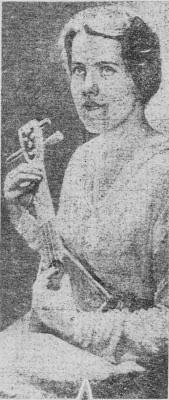E. F. A. Geach (b.
Essen, Germany, 24 May 1896; d. Cardiff, 10 August 1951)
Eleonora Frederika Adolphina Sgonina (her forenames were
sometimes spelled as Eleonore, Frederyka, or Adolfina) was the oldest of four
children of Adolf (sometimes Adolph) Sgonina (1870-1954) and his wife Eleonore
(1874-1949), who were German-Polish and who were married in 1895. Eleanora had three younger brothers. Her father was a civil engineer, and just
before the turn of the century the family settled in Cardiff, where Adolf
became Managing Director of an Iron Works. At least two of his son would follow
him in his profession.
Eleanora was educated at the City of Cardiff High School for
Girls, and she apparently attended Cambridge University in 1914-15, before she
registered as a Home Student at Oxford for the Hilary Term 1917. She kept terms
at Oxford for three years, concluding with the Michaelmas Term 1919. Her tutors included Miss C.A.E. Moberly (one
of the two pseudonymous authors of the famous slim 1911 book An Adventure, recounting their
apparently ghostly encounter during a summer 1901 visit at the Petit Trianon in
Versailles) and Miss Dorothy Sayers.
In between her time at Cambridge and Oxford, she married
George Hender Geach (1884-1941), who (though he was born and died in Cardiff)
worked in the Indian Education Service as a professor of philosophy at Lahore
(later, he was principal of a teacher’s training college in Peshwar). After a short
period of time in India, Eleanora returned to England for the birth of their one
child, Peter (born in Lower Chelsea in London in March 1916), who became a
distinguished philosopher. The marriage was unhappy and was quickly broken up. Up
until around the age of eight, Peter lived with his maternal grandparents in
Cardiff, after which time he was sent off to school by his father and raised by
a guardian. Peter Geach never saw his mother again after childhood.
As E.F.A. Geach, Eleonora began publishing poetry while at
Oxford. She collaborated on a small book of poems with a fellow student, D.E.A
Wallace, better known as Doreen Wallace (1897-1989), who became a prolific
novelist in the 1930s. The book was
entitled –Esques, and was published
by B. H. Blackwell in May 1918. It
includes eight poems by Geach, nine by Wallace, and one collaboration. The
poems are divided into six sections headed Arabesques, Burlesques, Fresques,
Grotesques, Humoresques, and A Picturesque, thus explaining the book’s odd title. One poem, “Episode”, in the Humoresques
section seems to refer to Geach’s marriage:
“I loved you for a year, / perhaps a little more . . ./ And now it’s all
over / And I feel as though I had never known you – / I feel no gaps, no
longing. / Your passage through my life / was like the flight of a bird through
the sky.” T.S. Eliot reviewed –Esques (very briefly) in The Egoist, noting wryly:
“The authors of –Esques trickle down a fine broad page in a pantoum, a roundel, a villanelle, occasionally pagan, mode of thirty years ago:Why then, O foolish ChristDidst thou keep trystWith maudlin harlots wanWith glad things gone?To which the obvious answer is. Why did you? Young poets ought to be made to be cheaply printed; such sumptuous pages deceive many innocent critics.” (August 1918, p. 99)
 |
| from Fifty New Poems for Children (1922) |
Geach, along with Dorothy Sayers and T.W. Earp edited Oxford Poetry 1918, also published by
Blackwell. Earp co-edited the annual volume for the years 1915 through 1919;
Sayers joined him for three years, 1917-1919. Geach was involved only for the
one year. In the 1918 volume there are two poems by Geach and a third in
collaboration with D.E.A. Wallace. One
of these poems, consisting of eight lines and titled “Romance”, seems to have
been an inspiration for J.R.R. Tolkien’s poem “The Road Goes Ever On”, the first
expression of which appears in the final chapter of The Hobbit, though its better-known versions appear in The Lord of the Rings. That Tolkien would have known the poem comes
from the fact (first noticed, I believe, by John D. Rateliff) that it was reprinted
immediately after Tolkien’s own poem “Goblin Feet” in Fifty New Poems for Children, a slim volume published by Blackwell
in 1922 (p. 28). The poem reads:
RomanceRound the next corner and in the next streetAdventure lies in wait for you.Oh, who can tell what you may meetRound the next corner and in the next street!Could life be anything but sweetWhen all is hazardous and newRound the next corner and in the next street?Adventure lies in wait for you.
Geach published one further booklet, Twenty Poems, which Blackwell released in March 1931. The poems
were all new to the booklet save for one, which was reprinted from The Poetry Review. These small volumes contain all of Geach’s known
writings. After her time in Oxford, she
returned to her family in Cardiff, where she died in 1951.





